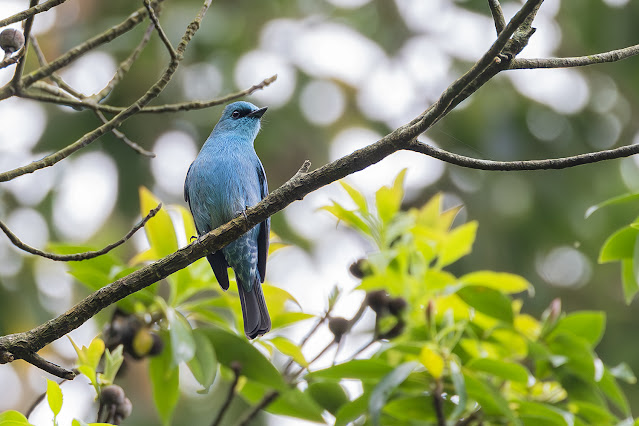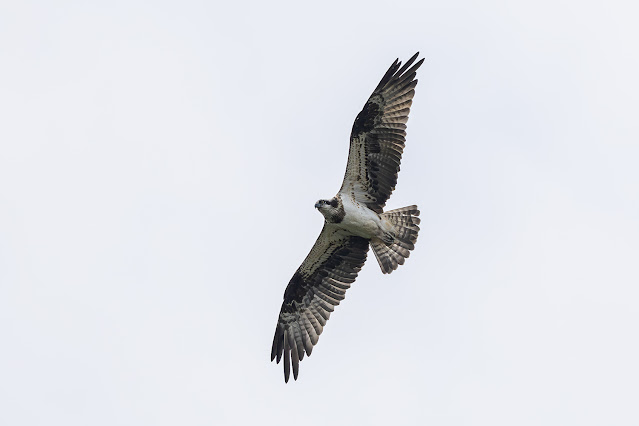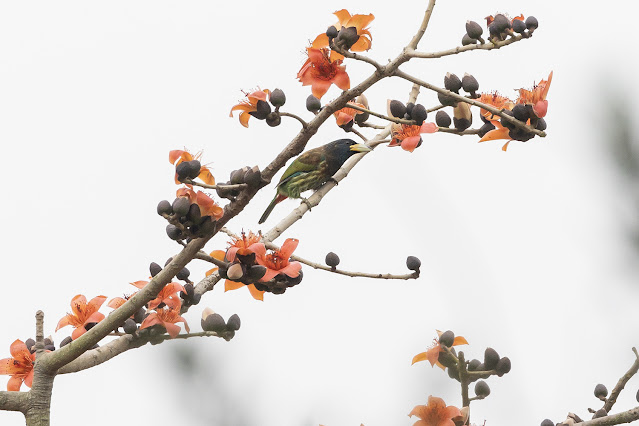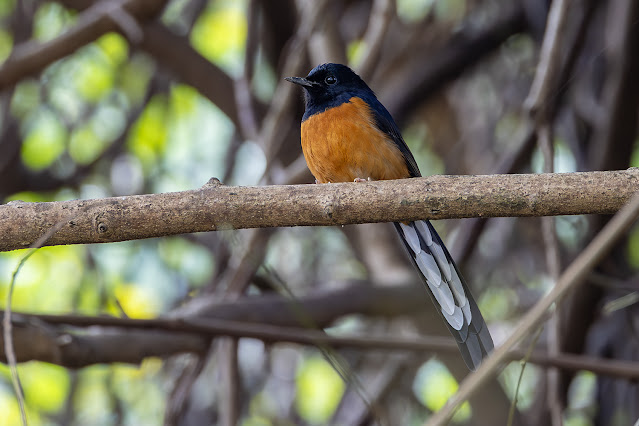The arrival of Oriental Pratincoles marks the proper beginning of spring migration, they are always a spring migrant that I enjoy seeing immensely, as they are graceful in the air, and simply quite elegant when perched. I saw my first two along the gravel roads at Tai Sang Wai.
 |
| Oriental Pratincole |
Many of our egrets are now moulting into their breeding plumage, such as this Eastern Cattle Egret, which is seen in full breeding plumage with bright orange head. Yellow Bitterns are present throughout the year, although their numbers do increase in spring and peaks during summer, I have been seeing quite a few of them in Mai Po, although I think most of them are over wintering birds instead of spring migrants.
 |
| Eastern Cattle Egret - breeding plumage |
 |
| Yellow Bittern |
My long staying Citrine Wagtail was still present up until earlier in the month, later on joined by a moulting male, its colours are really coming through now, I am hoping it will stay long enough that it will become a full breeding plumage male! Although I doubt it will stay that long, and is expecting its departure any day now. Around the same area there were at least a pair of Greater Painted Snipes.
 |
| Citrine Wagtail - likely female |
 |
| Citrine Wagtail - male assuming breeding plumage |
 |
| Greater Painted Snipe - male |
Some wintering birds remains, such as the Olive-backed Pipits which can still be found quietly walking around various parks or the footpaths at Mai Po. Ashy Drongo is one of our typical wintering forest bird, a few can still be found around Tai Po Kau, although I have a feeling they may be departing soon, as is the long staying Verditer Flycatcher there, which I have been fortunate enough to have seen on numerous occasions. While there are Chinese Blackbirds that breeds in Hong Kong, the majority of them are winter visitors, I had a very nice looking male on the side of the road one day.
 |
| Olive-backed Pipit |
 |
| Ashy Drongo - race leucogensis |
 |
| Verditer Flycatcher - male |
 |
| Chinese Blackbird |
Another long staying winter 'rarity' is the lonesome Greater White-fronted Goose at Mai Po, I caught up with it again one day, and was very glad to see its transformed into adult plumage. I was lucky that day and caught it walking around in front of the bird hide.
 |
| Greater White-fronted Goose - long staying rarity |
The single Carrion Crow have been relatively reliable at Mai Po and Lut Chau area, quite often following the local Collared Crows, I was lucky enough to have seen this one a couple of times.
 |
| Carrion Crow - another long staying rarity |
Other wintering birds lingering on includes a few Eastern Buzzards, while other larger birds of prey such as Imperial and Greater Spotted Eagles have mostly moved on, as they usually start doing so around March, Ospreys though often stay in Hong Kong a bit longer. The Black-capped Kingfisher out on the mudflat was still present, although not always presenting itself to visiting birders.
 |
| Eastern Buzzard |
 |
| Osprey |
 |
| Black-capped Kingfisher |
Over at Tai Po Kau, I managed a male Mrs. Gould's Sunbird, this is a wintering species in Hong Kong generally, and this winter have been a fairly good year for this species despite being generally a poor winter for other birds. This one surprisingly was not found on a flowering tree, but amongst other birds in a small bird wave.
 |
| Mrs. Gould's Sunbird - male |
A good sign of spring at Tai Po Kau is the constant call of barbets, espeically Chinese Barbets which are very vocal at this time of the year. I got lucky with one that showed relatively well, but heard at least two around the nature reserve. Great Barbets are difficult to see in Hong Kong, although they have been relatively stable near Tai Po Kau Park, where a few often visited the blooming bombax trees, still not a bird you can guarantee to see on every visit.
 |
| Chinese Barbet |
 |
| Great Barbet |
Many forest birds are now coming into song more frequently, Lesser Shortwings are definitely more vocal at this time of the year, and sometimes you get lucky with a good view as well! Plain Flowerpecker is another species that is most vocal during spring, and the best time of the year to see this otherwise reclusive species.
 |
| Lesser Shortwing |
 |
| Plain Flowerpecker |
Some birds have already paired up and is in the process of building nests, such as this pair of Blue-winged Minla. The large flocks of birds during winter is no more, they are now often replaced by birds in smaller groups or even pairs, although both the songs of Huet's Fulvetta and Silver-eared Mesia fill the forest at this time of the year.
 |
| Blue-winged Minla |
 |
| Huet's Fulvetta |
 |
| Silver-eared Mesia |
The favourite flower of the lovely Orange-bellied Leafbirds may have finished blooming, but the coral trees which blooms later on can also attract these colourful birds, I chanced upon a pair of them feeding on one of the coral trees and got some fantastic views! Fork-tailed Sunbirds and Mountain Bulbuls are also nectar loving birds, although it seems to me that by this time of the year, they are usually less dependant of flowering trees.
 |
| Orange-bellied Leafbird - male |
 |
| Orange-bellied Leafbird - female |
 |
| Fork-tailed Sunbird - male |
 |
| Mountain Bulbul |
Other fairly vocal species lately includes White-rumped Shamas, their beautiful song can be heard in various forest sites, they definitely have spread quite a lot and seems to be well established now in many places. Speckled Piculet on the other hand spread naturally and is becoming a very regular site and sound almost everywhere.
 |
| White-rumped Shama - male |
 |
| Speckled Piculet |
While there are areas where Asian Emerald Doves are easier to see, Tai Po Kau is not really one of them, I was quite happy to catch up with one fairly confiding individual there. A flock of Black-throated Laughingthrush frequents Tai Po Kau Park, a mixture of hainan race monachus and normal looking birds. Blue Whistling Thrush are also in song now, other than their diagnostic high pitch call, their extremely varied and complicated song can also be heard in the early hours of the day.
 |
| Asian Emerald Dove |
 |
| Black-throated Laughingthrush - race monachus |
 |
| Black-throated Laughingthrush |
 |
| Blue Whistling Thrush |













































































